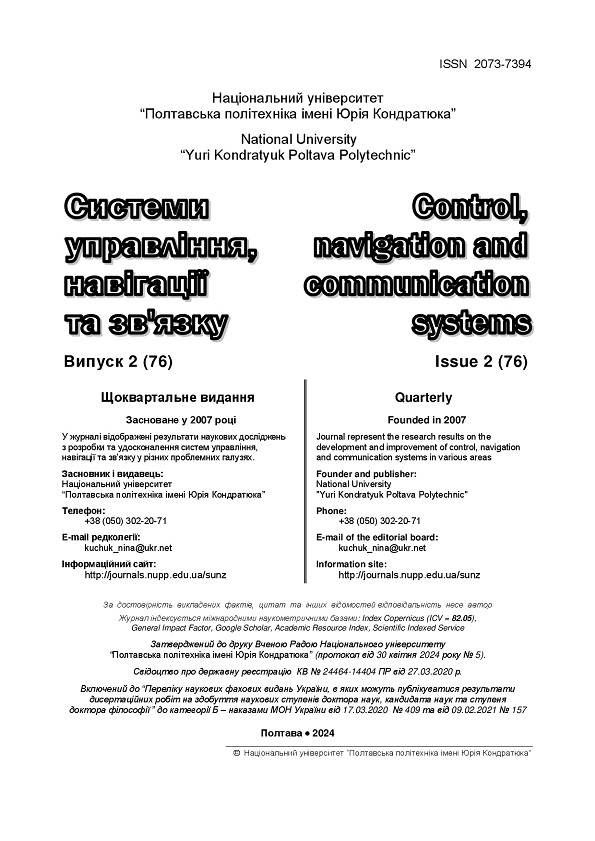OPERATION METHODS OF IOT DEVICES USING MACHINE LEARNING
DOI:
https://doi.org/10.26906/SUNZ.2024.2.078Keywords:
machine learning, computing node, IoT, sensor, protocol, FPGAAbstract
Relevance. The functioning of Internet of Things (IoT) devices using machine learning (ML) methods opens up many new op-portunities and advantages. These technologies make it possible to expand the functionality of traditional devices, giving them the ability to self-learn and adapt to changing environmental conditions or user behavior. IoT devices collect huge amounts of data from various sources such as temperature, humidity, motion sensors, etc. MN allows you to analyze these data, identifying patterns and trends. Using historical data, machine learning algorithms can predict future system states or user behavior, allowing devices to be optimized. The application of MN allows IoT devices to independently manage their functions, for example, to regulate lighting or temperature in the house, based on your habits and preferences. Algorithms can analyze electricity or water consumption and optimize their use, reducing costs and impact on the environment. MH can also help detect unusual behavior or attempts to gain unauthorized access to the system, increasing security. The ability to anonymize and protect data processed by IoT devices is critical, especially in the context of growing privacy concerns. Thus, the use of MH in IoT reveals the po-tential for creating innovative solutions that make our lives more convenient, safer and more efficient, which makes the topic of research in this area relevant. The purpose is to analyze the methods of functioning of IoT devices. The object is methods of data collection, pro-cessing and transmission in IoT computing nodes. The subject is the control of IoT computing nodes using machine learning. Results. An analysis of the methods of functioning of IoT devices was carried out. Applying methods to reduce signal transmission delay requires consideration of the specifics of a particular IoT system, including latency requirements, data types, computing and network resources, and the needs of the users or processes it serves. When using methods to reduce the amount of data transmitted, it should be taken into account that they require careful planning and configuration of the IoT system, taking into account the specifics of the application, data types and communication networks. This will help ensure optimal use of resources, increase scalability and reduce the cost of operating IoT systems. The implementation of data privacy and security methods requires a comprehensive approach to se-curity at all stages of the IoT system life cycle, from development and production to operation and decommission-ing of devices. The main challenges in data collection and analysis in IoT are ensuring data security and privacy, processing large volumes of data in real time, as well as the need for effective machine learning methods that can adapt to dynamic conditions and changing environments. The integration of advanced machine learning technolo-gies into the IoT opens up vast opportunities for creating more intelligent, efficient and autonomous systems that can revolutionize many areas of life, from smart homes to the industrial Internet of Things.Downloads
References
Дяченко В. Інтелектуальні підходи енергозбереження у безпровідних сенсорних комп’ютерних мережах // Системи управління, навігації та зв’язку. Збірник наукових праць. – Полтава: ПНТУ, 2020. – Т. 4 (62). – С. 114-118. – doi:https://doi.org/10.26906/SUNZ.2020.4.114.
Anand B., Edwin A., Hao J. Gamelets – Multiplayer mobile games with distributed micro-clouds". Seventh International Conference on Mobile Computing and Ubiquitous Networking (ICMU). 2014. pp. 14–20. doi:10.1109/ICMU.2014.6799051.
Verma A., Pedrosa L., Korupolu M., Oppenheimer D.; Tune E., Wilkes J. Large-scale cluster management at Google with Borg". Proceedings of the Tenth European Conference on Computer Systems. Article 18, sec. 2.1 (p. 1), sec. 6.1 (p. 11).2015. doi:10.1145/2741948.2741964
Boyd B., Gauci J., Robertson M., Nguyen V., Gupta R., Gucer V., Kislicins V. Building Real-time Mobile Solutions withMQTT and IBM MessageSight. IBM.2014.p.21-38.
Xing Y. et al. MPTCP Meets Big Data: Customizing Transmis-sion Strategy for Various Data Flows //IEEE Network. – 2020. – Т. 34. – №. 4. – С. 35-41.
Khan I., Chen K. EBA: Efficient Bandwidth Aggregation for Connected Vehicles with MPTCP //IEEE Internet of Things Journal. – 2021.
Коваленко А. А., Кучук Г. А. Методи синтезу інформаційної та технічної структур системи управління об’єктом критичного застосування. Сучасні інформаційні системи. 2018. Т. 2, № 1. С. 22–27. DOI: https://doi.org/10.20998/2522-9052.2018.1.04
Свиридов А. C., Коваленко А. А., Кучук Г. А. Метод перерозподілу пропускної здатності критичної ділянки мережі на основі удосконалення ON/OFF-моделі трафіку. Сучасні інформаційні системи. 2018. Т. 2, № 2. С. 139–144. DOI: https://doi.org/10.20998/2522-9052.2018.2.24
Palash M. R., Chen K., Khan I. Bandwidth-need driven energy efficiency improvement of MPTCP users in wireless networks //IEEE Transactions on Green Communications and Networking. – 2019. – Т. 3. – №. 2. – С. 343-355.




